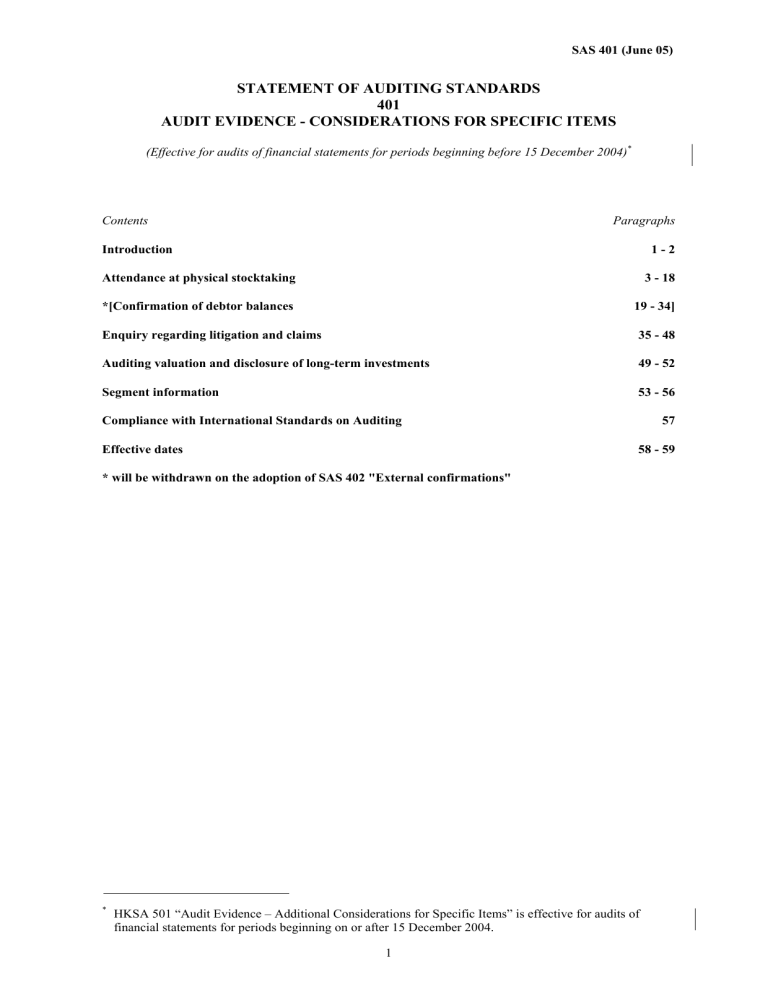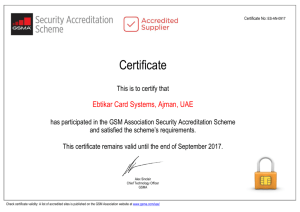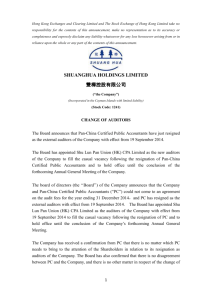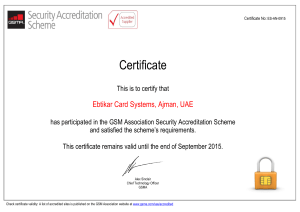SAS401 Audit Evidence - Hong Kong Institute of Certified Public

STATEMENT OF AUDITING STANDARDS
401
AUDIT EVIDENCE - CONSIDERATIONS FOR SPECIFIC ITEMS
(Effective for audits of financial statements for periods beginning before 15 December 2004)
*
Contents
Introduction
Attendance at physical stocktaking
*[Confirmation of debtor balances
Enquiry regarding litigation and claims
Auditing valuation and disclosure of long-term investments
Segment information
Compliance with International Standards on Auditing
Effective dates
* will be withdrawn on the adoption of SAS 402 "External confirmations"
Paragraphs
1 - 2
3 - 18
19 - 34]
35 - 48
49 - 52
53 - 56
57
58 - 59
*
HKSA 501 “Audit Evidence – Additional Considerations for Specific Items” is effective for audits of financial statements for periods beginning on or after 15 December 2004.
1
SAS 401 (revised August 01)
STATEMENT OF AUDITING STANDARDS
401
AUDIT EVIDENCE - CONSIDERATION FOR SPECIFIC ITEMS
Statements of Auditing Standards (SASs) are to be read in the light of SAS 010 "The scope and authority of auditing pronouncements". In particular, they contain basic principles and essential procedures, (auditing standards), indicated by paragraphs in bold italic type, with which auditors are required to comply in the conduct of any audit including those of companies applying section 141D of the Companies Ordinance.
SASs also include explanatory and other material which is designed to assist auditors in interpreting and applying auditing standards.
Introduction
1. The purpose of this Statement of Auditing Standards (SAS) is to establish standards and provide guidance additional to that contained in SAS 400 "Audit evidence". It assists the auditors in obtaining audit evidence with respect to specific financial statement amounts and disclosures.
2. This SAS comprises the following sections: a. Attendance at physical stocktaking
[b. Confirmation of debtor balances] c. Enquiry regarding litigation and claims d. Auditing valuation and disclosure of long-term investments e. Segment information.
The section "Confirmation of debtor balances" will be withdrawn on the adoption of SAS 402
"External confirmations".
Attendance at physical stocktaking
3. Management ordinarily establishes procedures under which stock is physically counted at least once a year to serve as a basis for the preparation of the financial statements or to ascertain the reliability of the perpetual stock system.
4.
When stock is material to the financial statements, the auditors should obtain sufficient appropriate audit evidence regarding its existence and condition by attendance at physical stocktaking by themselves or another auditor or a suitably qualified person representing them, unless impracticable. In exceptional circumstances the auditors may judge it necessary to depart from this procedure in order to more effectively achieve the same objective, however the auditors should document the justification for this departure in the audit working papers. (SAS 401.1)
5. Such attendance by the auditors enables them to inspect the stock, to observe compliance with the operation of management's procedures for recording and controlling the results of the count and to provide evidence as to the reliability of management's procedures. In limited cases due to factors such as the nature and location of the stock, the auditors would find it impractical to attend their clients' physical stocktaking. Under such circumstances the auditors would engage another auditor or a suitably qualified person as their authorised representative to attend the stocktake and to report on the results of his stocktake attendance to the auditors.
6.
Where attendance is impracticable, the auditors should consider whether alternative procedures provide sufficient appropriate audit evidence of existence and condition to conclude that the auditors need not make reference to a scope limitation in the auditors' report in accordance with
SAS 600 "Auditors' reports on financial statements". (SAS 401.2)
2
SAS 401 (revised August 01)
7. Alternative procedures may include taking or observing some physical counts on an alternative date and testing intervening transactions to the period end. If the nature of work in progress is such that its existence cannot be verified by a physical count then alternative procedures may include examining supporting costing records, work tickets, evidence of purchases and sales and testing of the internal controls as well as physical inspection.
8. In planning attendance at the physical stock count or the alternative procedures, the auditors would consider matters set out below. a. The materiality of stock. b. The nature of the stock, for example, whether it comprises work in progress. c. The nature of the accounting and internal control systems used regarding stock. d. Inherent, control and detection risks related to stock. e. Whether adequate procedures are expected to be established and proper instructions issued for physical stocktaking. f. The timing of the count. g. The locations at which stock is held. h. Whether an expert's assistance is needed.
9. When the quantities are to be determined by a physical stock count and the auditors attend such a count, or when the entity operates a perpetual stock system and the auditors attend a count one or more times during the period, the auditors would ordinarily observe count procedures and perform test counts.
10. If the entity uses procedures to estimate the physical quantity, such as estimating a coal pile, the auditors would seek to be satisfied regarding the reasonableness of those procedures.
11. When stock is situated in several locations, the auditors would consider at which locations attendance is appropriate, taking into account the materiality of the stock and the assessment of inherent and control risks at different locations.
12. The auditors would review management's instructions regarding: a. the application of control procedures, for example, collection of used stocksheets, accounting for unused stocksheets and count and re-count procedures; b. accurate identification of the stage of completion of work in progress, of slow moving, obsolete or damaged items and of stock owned by a third party, for example, on consignment; and c. whether appropriate arrangements are made regarding the movement of stock between areas and the shipping and receipt of stock before and after the cut-off date.
13. To obtain assurance that management's procedures are adequately implemented, the auditors would observe count procedures and perform test counts. When performing counts the auditors would test both the completeness and the accuracy of the count records by tracing items selected from those records to the physical stock and items selected from the physical stock to the count records. The auditors would consider the extent to which copies of such count records need to be retained for subsequent testing and comparison.
14. The auditors would also consider cut-off procedures including details of the movement of stock just prior to, during and after the count so that the accounting for such movements can be checked at a later date.
15. For practical reasons, the physical stock count may be conducted at a date other than period end. This will ordinarily be adequate for audit purposes only when control risk is assessed at low or a perpetual stock system is operated by the entity. The auditors would assess whether, through the performance of appropriate procedures, changes in stock between the count date and period end are correctly recorded.
3
SAS 401 (revised August 01)
16. When the entity operates a perpetual stock system which is used to determine the period end balance, the auditors would assess whether, through the performance of additional procedures, the reasons for any significant differences between the physical count and the perpetual stock records are understood and the records are properly adjusted.
17. The auditors would test the final stock listing to assess whether it accurately reflects actual stock counts.
18. When stock is under the custody and control of a third party, the auditors would ordinarily obtain direct confirmation from the third party as to the quantities and condition of stock held on behalf of the entity. Depending on materiality of this stock the auditors would also consider matters set out below. a. The integrity and independence of the third party. b. Observing, or arranging for another auditor to observe, the physical stock count. c. Obtaining another auditor's report on the adequacy of the third party's accounting and internal control systems for ensuring that stock is correctly counted and adequately safeguarded. d. Inspecting documentation regarding stock held by third parties, for example, warehouse receipts, or obtaining confirmation from other parties when such stock has been pledged as collateral.
Confirmation of debtor balances
This section will be withdrawn on the adoption of SAS 402 "External confirmations".
19.
When debtor balances are material to the financial statements and when it is reasonable to expect debtors will respond, the auditors should plan to obtain direct confirmation of debtor balances or individual entries in an account balance. The auditors may judge it necessary to depart from the requirement to obtain direct confirmation in order to more effectively obtain audit evidence as to the existence of debtor balances, however the auditors should document the justification for this departure in the audit working papers.(SAS 401.3)
20. Direct confirmation may provide reliable audit evidence as to the existence of debtors and the accuracy of their recorded account balances. However, it does not ordinarily provide evidence as to the collectibility of balances or as to existence of unrecorded debtor balances.
21.
When it is expected that debtors will not respond, the auditors should plan to perform alternative procedures. (SAS 401.4)
22. An example of such alternative procedures would be examining subsequent cash receipts related to the specific account balance or individual entries at period end.
23. The accounts to be confirmed are selected to enable the auditors to reach an appropriate conclusion as to existence and accuracy of the debtor balances as a whole, taking into account identified audit risks and other planned procedures.
24. Letters requesting confirmation are sent by the auditors, and debtors are requested to reply directly to the auditors. Such letters contain management's authorisation to the debtor to disclose the necessary information to the auditors.
25. The request for confirmation of balances may take a positive form, in which the debtor is asked to confirm agreement or to express disagreement with the recorded balance, or a negative form, in which a reply is requested only in the event of disagreement with the recorded balance.
26. Positive confirmations provide more reliable evidence than negative confirmations. The choice between positive and negative forms would depend upon the circumstances, including the assessment of both inherent and control risks. The positive form is preferred since with the negative form, no reply may be due to causes other than agreement with the recorded balance.
27. A combination of positive and negative forms may be used. For example, where the total debtor balance consists of a small number of large balances and a large number of small balances, the auditors may decide that it is appropriate to confirm all or a sample of the large balances with positive confirmation requests and a sample of the small balances using negative confirmation requests.
4
SAS 401 (revised August 01)
28. When the positive form is used, the auditors would ordinarily send a reminder to those debtors who do not reply within a reasonable time. Replies may contain exceptions which would need to be fully investigated.
29.
If a reply to a positive confirmation is not received, alternative procedures should be applied or the item treated as an error. (SAS 401.5)
30. Examples of such alternative procedures are the examination of subsequent cash receipts or examining sales and dispatch documents. Items for which a reply has not been received and for which alternative procedures have not been performed, would be treated as errors for the purpose of evaluating the audit evidence provided by the audit sample.
31. For practical reasons, when control risk is assessed at low the auditors may decide to confirm debtor balances at a date other than period end, for example, when the audit is to be completed within a short time after the balance sheet date. In such cases, the auditors would review and test intervening transactions as deemed necessary.
32.
When management requests the auditors not to confirm certain debtor balances, the auditors should consider whether there are valid grounds for such a request. (SAS 401.6)
33. For example, if the particular account is in dispute with the debtor and communication on behalf of the auditors may aggravate sensitive negotiations between the entity and the debtor.
34.
Before accepting a refusal as justified, the auditors should examine any available evidence to support management's explanations. In such cases, the auditors should apply alternative procedures to the debtor balances not subjected to confirmation and consider the effect on their opinion in accordance with SAS 600 "Auditors' reports on financial statements" if alternative procedures do not provide sufficient appropriate audit evidence. (SAS 401.7)
Enquiry regarding litigation and claims
35. Litigation and claims involving an entity may have a material effect on the financial statements and thus may be required to be disclosed and/or provided for in the financial statements.
36.
The auditors should carry out procedures in order to become aware of any litigation and claims involving the entity which may have a material effect on the financial statements. (SAS 401.8)
37. Such procedures would include steps set out below. a. Making appropriate enquiries of management including obtaining a list of matters referred to solicitors (or lawyers), if any, and representations. b. Reviewing board minutes and correspondence with the entity's solicitors. c. Examining legal expense accounts. d. Using any information obtained regarding the entity's business including information obtained from discussions with any in-house legal department.
38.
When material unresolved litigation or claims have been identified or when the auditors believe they may exist, the auditors should seek direct communication with the entity's solicitors. (SAS 401.9)
39. Such communication would assist in obtaining sufficient appropriate audit evidence as to whether potentially material litigation and claims are known and management's estimates of the financial implications, including costs, are reliable.
40.
The enquiry letter to the solicitors, which should be written and authorised by management and physically delivered/posted by the auditors, should request the solicitors to communicate directly with the auditors. (SAS 401.10)
41. As the Council of the Law Society of Hong Kong has advised solicitors that it is unable to recommend they comply with non-specific requests for information from auditors, the letter would ordinarily specify matters set out below. a. A list of litigation and claims.
5
b. Management's assessment of the outcome of the litigation or claims and its estimate of the financial implications, including costs involved. c. A request that the solicitors confirm the reasonableness of management's assessments and provide the auditors with further information if the list is considered by the solicitors to be incomplete or incorrect.
42. The following form of wording, appropriate to specific enquiries, has been agreed with the Council of the Law Society of Hong Kong as one which may be properly addressed to and answered by solicitors:
"In connection with the preparation and audit of our accounts for the year ended ...... the directors have made estimates of the amounts of the ultimate liabilities (including costs) which might be incurred, and are regarded as material, in relation to the following matters on which you have been consulted. We should be obliged if you would confirm that in your opinion these estimates are reasonable.
Matter Estimated liability including costs"
43. The Council of the Hong Kong Institute of Certified Public Accountants understands the reasons for the view of the Council of the Law Society of Hong Kong regarding non-specific enquiries, but nevertheless believes that there may be circumstances in which it is necessary as an audit procedure for an enquiry of a general nature to be addressed to the solicitors in order to confirm that the information provided by the directors is complete in all material particulars.
44. It may be necessary for auditors to make reference to local requirements if they are making enquiries of overseas solicitors as different form of wording for the enquiry letter to lawyers might have been agreed between the local professional accountants and lawyers associations.
45. The auditors consider the status of legal matters up to the date of the auditors' report. In some instances, the auditors may need to obtain updated information from the solicitors.
46. In certain circumstances, for example, where the matter is complex or there is disagreement between management and the solicitors, it may be necessary for the auditors to meet with the solicitors to discuss the likely outcome of litigation and claims. Such meetings would take place with management's permission and, preferably, with a representative of management in attendance.
47.
If management refuses to give the auditors permission to communicate with the entity's solicitors, this would be a scope limitation and should ordinarily lead to a qualified opinion or a disclaimer of opinion in accordance with SAS 600 "Auditors' reports on financial statements". (SAS 401.11)
48. Where the solicitors refuse to respond in an appropriate manner and the auditors are unable to obtain sufficient appropriate audit evidence by applying alternative procedures, the auditors would consider whether there is a scope limitation which may lead to a qualified opinion or a disclaimer of opinion in accordance with SAS 600 "Auditors' reports on financial statements".
Auditing valuation and disclosure of long-term investments
49.
When long-term investments are material to the financial statements, the auditors should obtain sufficient appropriate audit evidence regarding their valuation and disclosure. (SAS 401.12)
50. Audit procedures regarding long-term investments ordinarily include considering evidence as to whether the entity has the ability to continue to hold the investments on a long term basis and discussing with management whether the entity will continue to hold the investments as long-term investments and obtaining written representations to that effect.
51. Other procedures would ordinarily include considering related financial statements and other information, such as market quotations, which provide an indication of value and comparing such values to the carrying amount of the investments up to the date of the auditors' report.
52. If such values do not exceed the carrying amounts, the auditors would consider whether a write-down is required. If there is an uncertainty as to whether the carrying amount will be recovered, the auditors would consider whether appropriate adjustments and/or disclosures have been made.
6
Segment information
53.
When segment information is material to the financial statements, the auditors should obtain sufficient appropriate audit evidence regarding its disclosure in accordance with the identified financial reporting framework. (SAS 401.13)
54. The auditors consider segment information in relation to the financial statements taken as a whole, and are not ordinarily required to apply auditing procedures that would be necessary to express an opinion on the segment information standing alone. However, the concept of materiality encompasses both quantitative and qualitative factors and the auditors' procedures recognize this.
55. Audit procedures regarding segment information ordinarily consist of analytical procedures and other audit tests appropriate in the circumstances.
56. The auditors would discuss with management the methods used in determining segment information, and consider whether such methods are likely to result in disclosure in accordance with the applicable financial reporting framework and test the application of such methods. The auditors would consider sales, transfers and charges between segments, elimination of inter-segment amounts, comparisons with budgets and other expected results, for example, operating profits as a percentage of sales, and the allocation of assets and costs among segments including consistency with prior periods and the adequacy of the disclosures with respect to inconsistencies.
Compliance with International Standards on Auditing
57. Compliance with the auditing standards contained in this SAS ensures compliance in all material respects with the basic principles and essential procedures in International Standard on Auditing 501
"Audit Evidence - Additional Considerations for Specific Items".
Effective dates
58. This SAS is effective for audits of financial statements for periods beginning before 15 December
2004.
7









